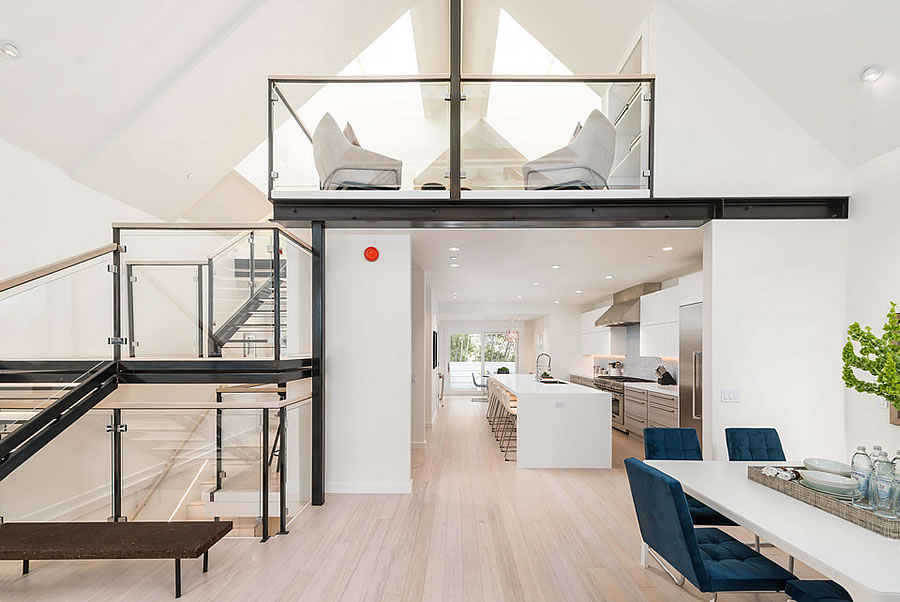Built in 1895, the Noe Valley Victorian at 228 Day Street was completely renovated and redesigned as a 2,370-square-foot “Neo-Victorian” home two years ago, with an open floor plan, soaring ceiling, exposed steel beams, high-end finishes and a modern staircase connecting its floors.
Purchased post-renovation for $2.45 million in May of last year, the three-bedroom home returned to the market listed for $2.398 million last month.
And the re-sale of 228 Day has now closed escrow with a contract price of $2.4 million, officially “over asking” but 2 percent ($50K) under the price the modern Noe Valley home fetched 14 months ago.








I am happy to see any decreases in apples to apples for sure. However, I’d most like to see an apples to apples decrease for an sfh under 1.1 mill in the city. I am hoping Condos in soma and 2mill plus homes are a harbinger for the sfh market but i fear they are just a different segment with different price elasticity.
Momentum affects a wide swath of the market. Many many people can buy a $700k home that shoots up to $1M. And in this globalized economy, a $2.5M home that shoots up to $3.7 will have many takers as well. But both a $1M home dropping to $700k and a $3.5M home on the same downward trajectory will have a radically smaller space of willing and able buyers.
Generally people on the lower end of the income scale will have disproportionately fewer savings than those in higher income brackets. And with lower savings thus less able to bear the deleterious effects of downward price momentum.
The catch is that while those with more wealth may have more ability to throw their equity into the meat grinder of a falling market, they will mostly not want to. The way you make and keep wealth is by avoiding opportunities to lose it.
In the 2007 bubble, we very clearly saw that that people at all income (or even lack of any income) levels (and thus home price levels) were playing the momentum game. This time around the very low end has been cut off from the lending system, but the very low end of the US income spectrum lies far below the price of entry into the SF market space.
This Reno did more harm than good. This level of modern open plan is reserved for lofts and modern condos. Families and house people loathe this stuff..
Maybe they’re targeting buyers coming from lofts and modern condos who don’t want to “go back in time” when upgrading.
Simple solution: Go find a mid-century crap box that is halfway there to being a contemporary house.
Glad to see they lost money on this. Gutting Victorians like that shouldn’t even be allowed.
What makes you think they lost money on this? Were you the accountant on the project?
And gutting victorians shouldn’t be allowed? So you want to bring the city into your bed? Would you also want the city to decide who can live there?
– “City here. How can I help you.”
– “I want to have my aunt move in with me.”
– “Not allowed. You’ll need a permit for that. Commission hearings for move-ins are backlogged, we can tentatively schedule you 3-4 years from now. But hearings are cancelled from time to time, so set your hopes on 6-8 years.”
It’s your damn property, do with it as you please.
As the article states:
“And the re-sale of 228 Day has now closed escrow with a contract price of $2.4 million, officially “over asking” but 2 percent ($50K) under the price the modern Noe Valley home fetched 14 months ago.”
Ha! Best post ever. To each their own. People like what they like and the only person this house matters to is the buyer. Congratulations to the new home owner!
After much design and re-design, I finally decided not to install a bathtub in my main bathroom. It would have made everything else (i.e. shower, vanity, toilet area) much smaller. Not worth sacrificing so much for one tub. Now I can have a wide open airy space with the items listed above much bigger. I am sure someone will be screaming they can’t live without a bathtub.
No, they won’t scream about that.
I mostly agree with Cythia;
I toured this house several times, since I used to live just 2 blocks up the hill.: awkward open floor plan, no defined living and dining areas, open “lofty” style glass stairway (which seemed crude) leading to a sort of useless loft above, all bedrooms on lower level with small windows and very little natural light, back yard was about 10′ deep. Laundry in the garage. The worst aspect: The garage was NOT to code in terms of dimension for one car parking.
My own house, which was fully remodeled from foundation to roof, with classic but modern interiors with a REAL dining room, eat-in kitchen, 3 bedrooms with lots of windows, 3 baths, large south yard and a REAL 2 car garage; Victorian character maintained but not turned into a museum.
Sold for $600k over asking in 6 days. So, yes. Gutting Victorians into some faux, glitzy loft can turn into a real money loser.
I don’t know what you’re referring to with the garage, but if it’s what I’ve seen in the house around the corner from me (in NV), they’ll have a garage that is about 10ft deep, if that. I doubt anything longer than a Fiat would let them close the garage door, probably not a Mini Cooper and definitely not a Prius.
I measured the garage in the subject property. It was approximately 12 feet long. Code defines a single car space as 9′ wide by 18′ long.
How it got past the illustrious SF building dept. is beyond me, but it did.
I didn’t like the reverse floor plan. Maybe some people are OK with them, but I just didn’t like the bedrooms downstairs.
The $2.45M sale price in May, 2016 was post-renovation.
The folks who gutted the home purchased it in April, 2015 for $1.315M, meaning the folks who gutted the property sold it for ~$1.1 over their original purchase price.
Coulda made money.
You seem to assume that the interior was in mint condition before the reno. For all we know, the house could have had shag carpets, linoleum floors and a 1970’s-era fake wood panel kitchen with harvest gold appliances.
Wow. First, that is mean, wishing ill on one of your neighbors (Karma is a bitch Cynthia). Second, are we about to set up a Good Taste Panel in City Hall. If it is not visible from the street, does not affect your neighbors and it is not against building codes and zoning, from my point of view, it is NONE OF YOUR BUSINESS.
Seems about right to me. Not super close to good public transportation. Mishmash of features. Kitchen has low ceilings.
Where’s the SFH holds value better crowd?
It’s less than a block from a J-Church stop and a block from a 24 stop. That’s pretty close to public transit.
It’s about 300 feet to a J-church stop.
What is this thing called ‘public transportation’ anyway?
In addition to being near the J Church, it is also has excellent access to 280.
And they’re all made out of ticky tacky
And they all look just the same
Seems like the market for live-in post modern art museums in residential neighborhoods is limited.
I’ll continue to represent the pro-reno point of view, without commenting on this specific units aesthetics.
We don’t live in 1905 anymore, where you had servants hiding in the kitchen cooking for you then passing food through a small interior window, or where socializing was highly formal, in formal rooms. Society has changed.
We don’t live in 1905 anymore, where burning wood in fireplaces was the only heat so we needed lots of compartmentalized rooms. Bulky fireplaces are now an earthquake and fire risk, first and foremost. There weren’t any power outlets needed because there was no power. Technology has changed.
I fully support renovations which manage to keep the intricate wood carvings intact. I love all of that stuff and respect the art, and the history. But times change. Our housing needs to, as well.
Amen
So, in 2017 we have energy to literally burn? (super high ceilings, heating areas not needed or used). I ‘get’ the asthetic – the spaciousness, the free-flow, the sense of light permeating …
But do families or couples really use all the space? or are they planted most of the time at a computer or wide-screen? Sure large areas are great for gatherings, but does it need to go in every residence?
I agree with you that insanely high ceilings are not necessary, and in fact can feel awkward.
I think families do/will use the space. The concept of induced demand likely applies here: if you have a big room, you’ll likely host more just because you can. Also, one big room encourages a family to hang out together. They might be scattered about (kitchen/dining table doing homework, couch reading) but they are all within conversational distance. Compartmentalized rooms encourages isolation, one person per room.
+1
Living in a modern condo with open floor plan, I dread idea of losing the open space when “upgrading” to a SFH in SF. Not planning to move in the next 5 years, but I wonder if I’ll want to live in a house with limited power outlets and many small rooms over the open floorplans such as one in this unit.
It’s not the developer that lost money but the purchaser who sold after one year. I’m surprised at this selling price of a newly renovated San Francisco home I wonder if there is some issue that’s not obvious to people who haven’t toured the house.
Read my recent comments and you’ll see why.
i’m always curious what causes one to buy million dollar properties to only sell them 1 year later. of course things like “life happens” – job relocation, divorce, etc. but i wonder how many cases are buyer’s remorse.
I think in this case it might be an example of “white guilt”
🙂
a paint job would have fixed that 🙂
These comments are deja vu for the last meltdown. There’d be an apples to apples sale, and all the boosters and real estate agents would come out and say “well, it’s on a busy street”, as if it had moved since the last sale.
The complaints about this house don’t address the fact that the house had all those things wrong with it when it was last purchased. However, someone felt the need to pay more, with all its warts, then than they do now. Even the realtor knew it wouldn’t sell for what they paid for it.
To their $50K loss, add $125K in commissions and staging, $80K in interest expense after tax deductions, $18K in transfer taxes, and $40K in property taxes, and they paid something north of $300,000 to live for 14 months, or well over $20,000 per month to live in a 3 bedroom home in Noe. A high end but not so modern, but larger 4 bedroom 3.5 bath will run under $10,000 on the rental market.
though i think there’s a minor twist to this kind of apple to apple “market” price comparison. when this owner paid 2.45M (exactly $2,450,000) last year, presumably there was no other willing buyer at this price. so the “market value” of this house – minus him – would have been a bit less than 2.45M, and we don’t know if it was 50K less or not (not knowing the 2nd highest bid).
But isn’t that also true now?
Presumably there was no other willing buyer at this *current* time. so the “market value” of this house – minus him – would have been a bit less than 2.4M.
The market price of something is the price at which transactions actually occur. Not the price that a transaction hypothetically would have occurred with a potential different buyer.
i think the effect is more pronounced when it’s about custom homes that are bought and sold almost immediately afterwards. say there was a custom home where everyone bid close to 1.9M, but one guy comes i and bids 2.1M to make sure he got the house. if for some reason he sells it very soon afterwards, he should not expect the price that he can fetch to be 2.1M — even though 2.1M would have been the recognized “market value” after he himself bought the house — since it was evidenced that everyone buy him thought the house was only worth 1.9M.
This is not deja vu all over again at all. During the crisis, the broad indexes (case shiller, MLS medians) were all down significantly, in SF and nationwide. You had “apples to apples” sales in SF that were down 20% or 30% or 40% or more. And yet you had the realtors saying “not here” and trying to excuse the declines in prime areas like you note.
That’s not what we have here. The broad indexes show continuing slight increases. The July MLS numbers are quite strong in terms of medians and averages. Inventory continues to be very tight, unlike during the crisis. The editor has glommed onto one b.s. “Marks Company report” that is meaningless which shows things down 20% or up 9% depending on the month and is limited to some unspecified new construction in any event. It is true there have been a small number of “apples” that have declined in the last year or two. And there have been far more that have appreciated that the editor ignores (Here is one, 2421 16th St. 303 in the Mission: Mar 2015 for $1,149,000, sold yesterday for $1,280,000). I know a lot of people really, really want to say “called it!!!” but there is no “it” to call at this point. Any honest assessment shows that SF prices plateaued or are perhaps up a few % in the last year and the last couple of years. Might prices fall going forward, even significantly? Sure. But they haven’t yet. I’m confident the editor will continue to highlight those places that sell for less and disregard those that go the other way.
And – you are absolutely right that this particular sale was a really expensive bad move by the buyer in 2016.
Weren’t you one of the people looking at all the leading indicators of weakness a few months back and declaring that while anything could be possible there was no evidence of anything other than business as usual?
And of course individual data points (apples) lead the broader averages. How could you possibly have a broader average down 2% below 2016 *before* any data points showing that decline?
“During the crisis, the broad indexes (case shiller, MLS medians) were all down significantly, in SF and nationwide.”
And here you keep making the same misleading comparison between the down-slope of the last market cycle and the current turn from up to flat of this market cycle.
Even in the last 2007 cycle after the up-slope turned, the market flattened for a good 18-24 months before the serious downturn began. The market didn’t go from straight up immediately to straight down last time. So the fact that we haven’t gone from straight up to immediately showing large drops in Case Shiller does not bolster the case in any way that “this time it’s different”.
“And of course individual data points (apples) lead the broader averages”
Do I really need to explain the significance, or lack thereof, of an individual data point that goes into a broader index? Oh well – if the broader index is up, that means there are more “up” data points than “down” (as a general principle). But if you only look at the “down” data points, you might miss this.
When case shiller and the MLS data indicate a down market, and there are lots more “down” apples than “up” apples, then we will be in the situation of the downturn 8-9 years ago when some realtors were still insisting “not here.” When the market flattened in 2007 we were not in a downturn (“serious” or otherwise). May get there, of course, like we saw in 2008 and for several years after. But that is very different from saying “already there.”
“When the market flattened in 2007 we were not in a downturn”
You are comparing markets to on/off switches. Markets aren’t a binary paradigm. They have to flatten before they turn down; the process isn’t linear, and data will be mixed and conflicting during this process. Why? Because markets are subject to human behavior, not physics.
It is undeniable that we have gone from a market in which for five or six years there were zero data points indicating market problems, to one in which there are many data points indicating market problems.
To get to a down market in which there are no data points indicating an up market from an up market in which there are no data points indicating a down market, we have to go through a period of mixed data points.
When you see a baseball thrown up in the air, as it slows down as it approaches the apex, do you say, “it’s not going down yet; we may get there, but there’s no evidence for that — the data say we are still going up!”
Do you really believe in this nonsensical binary paradigm, or are you just being disingenuous?
I think we’re all at least in agreement that the market is not already down, which was my point. You’re now saying, “okay, but it will go down because it has flattened.” Maybe, but not necessarily. When a market goes up and then flattens, it could either then (a) go up again, (b) continue flat, or (c) go down. That is all I’m saying. When the market flattened second half of 2014, it then went up again after that. Flat ≠ necessarily-soon-to-be-down, as you are arguing. Although I agree that is certainly possible. This is really not complicated or controversial. Housing markets are not baseballs tossed into the air.
“Flat” markets are rare and brief, are indeed similar to a ball momentarily suspended at its apex. Look at the historical data: housing graphs clearly show markets are almost always either going up or down. Markets go through a process of flattening as they reverse course, but they spend little time being “flat.” Flat is a restate booster’s euphemism for “softening market” (which is also a euphemism…).
SF had 4-5 years of a flat market in the mid-90s. Not rare or necessarily brief. And just as likely to be followed by more gains as a downturn.
Here is another, by the way. 146 Highland Av: 2Br 1 Ba sold for $950,000 in March 2015 and just sold today for $1,050,000. Looks from the broader indexes and the larger number of comps that we’re not even to “flat” yet but are still in “up.” But I agree that things could always turn down (or up more, or flat) in the future.
The problem with the boom-flatten hypothesis from the demand side is this:
Imagine that you are presented with two condos side by side. Identical in every way except that one condo comes with $300k in cash stuffed in the closet while the other one does not.
As you are fond of saying: “Anything is possible”, but how likely is it that buyers will be indifferent between these two condos? That the demand for and price paid for both condos will on average be the same?
When prices were rising strongly, buyers were looking at getting a large chuck of equity delivered to them with their home purchase in a few short years. When prices flatten, this large equity bonus goes away. It beggars belief that buyers on average will simply shrug off the disappearance of this windfall and continue to bid as feverishly as before.
And when prices slowly start to tilt downward, in the analogy above you are looking at a third condo. One which not only contains no cash in its closet, but additionally chips away at your equity year by year. How likely is it that buyers will be indifferent to this vs the condo with the pile of cash?
You certainly have a flair for adjectives (most, more, largely, larger) and statements of “fact” that aren’t based on any actual analysis (not to mention counterfactual examples that are typically far afield from the segments at hand).
In terms of the various indexes and their trends, keep in mind that every single recent home sale in San Francisco proper could close at a lower (“down”) value than the year before, or even the year before that, without causing the broader Case-Shiller Index or median sale price in San Francisco to dip (at which point you’re well past the point at which the market started to turn).
And in terms of the condo pricing index with which you seem to be fixated, it’s simply another data point and perspective we track along with a much larger mix of indicators and metrics.
When you start arguing that the broader indexes trending up really means that prices are falling, you’re just in the land of nonsense. This is no different from the realtor cheerleaders arguing 8-9 years ago that prices were really holding steady in SF (“fear tactics are dead”) even though all the broad measures indicated prices were down significantly.
And I understand your point. But a hypothetical, conceivable, not impossible maybe does not mean “is.”
When you start arguing that the broader indexes trending up really means that prices are falling, you’re just in the land of nonsense.
We wholeheartedly agree. A close second, in terms of nonsense, would be a strawman attack countering something we never said.
That’s “scare tactics are dead” buddy, there’s no such thing as “fear tactics”. And “He-Who-Must-Not-Be-Named” Lord Kohldemort threw down that nugget of real estate wizdom right before the SF market fell off a cliff.
fear mongering/scare tactics mash-up. Apologies.
whole heartedly, editor!
[Editor’s Note: We’d love to blame auto correct but that was simply sloppy work on our part. Cheers (and since corrected above).]
All this denial (the stats are just fear mongering) and rationalization (Its on a busy street, it’s just condos,…) mentioned above are one of the key reasons that prices don’t go from straight up to straight down.
Most people don’t follow niche real estate sites like this one day to day and many probably don’t even know what case-shiller is. And even once the average person gets the information, they go through a period of denial and rationalization as well.
So while flatting out at a high level is not a stable state, the RE market is not run by hyper-rational HFT computers which instantly latch onto this fact and act on it. The average person takes time to collect and process market information, make a decision and then act on it.
The market flattened out for about 18-24 months last time before everyone saw and understood the writing on the wall. And as you point out, the real estate industry actively encouraged this denial.
So, what’s the average amount that properties featured here on SS have traded down?
Are we 1.5 or 2.5 or 3.5% lower than previous highs?
This is an inferior outcome from the design standpoint. White box with superior finishes. Loss of contextuality. The marketability implies the destruction of the local vernacular circa 1900 interior finish.
You seem to assume that the house had a circa 1900 interior finish. For all we know, it could have been badly updated in the 1970s with shag carpet, cheap wood veneer cabinets, etc.
The kitchen had a 1990s reno on it, but the rest was quite original. All the original crown molding, lincrusta, wainscoting, hardwood floors, clawfoot tub, fireplace mantle (sans tile), and built-ins were still there. This was not a too-far-gone Victorian; this was a decently intact interior that got destroyed.
It might also have been an earlier – and sympathetic – recreation of (what was perceived to have been) the original interior: the wainscotting, trim, etc are all quite simple and it’s hard to date them exactly, and the living room seems to have not much more than the rosette in the ceiling.
But of course whenever it appeared it was a better match for the exterior than this.